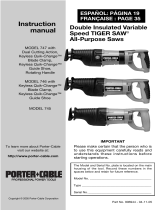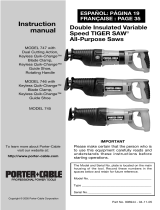
Removing and Replacing the Quik-Lok® Cord
Select Models (Fig. 1)
1. To remove the Quik-Lok® Cord, turn the cord nut 1/4 turn
to the left and pull it out.
2. To replace the Quik-Lok® Cord, align the connector key-
ways and push the connector in as far as it will go. Turn the
cord nut 1/4 turn to the right to lock.
Selecting a Blade
Use MILWAUKEE Sawzall Blades for best performance.
When selecting a blade, choose the right type and length.
Many types of blades are available for a variety of applica-
tions: cutting metal, wood, nail-embedded wood, scroll cut-
ting, roughing-in, and contours.
Many lengths are also available. Choose a length long
enough to extend beyond the shoe and your work throughout
the stroke. Do not use blades less than 3-112" long since
they won't extend beyond the shoe throughout the stroke.
For best performance and longest life, see "Accessories" to
select the best blade for the job.
IInstalling and Removing Blades
Blade Clamp Select Models (Fig. 2)
Unplug the tool before changing blades. Be sure the spindle
and blade clamp area are clean. Metal chips and sawdust may
prevent the blade clamp screw from clamping securely.
1. Depending on the job, the blade may be inserted with the
teeth facing upward or downward.
To install a blade, loosen the blade clamp screw, turning it
counterclockwise. Insert the blade until the tang butts against
the spindle.
NOTE: The blade must be inserted all the way into the spin-
dle so that the tang on the blade seats firmly in the blade
clamp.
Insert the hex key into the blade clamp screw, turning it
clockwise. Tighten securely.
2. To remove a blade, insert hex key into the blade clamp
screw and turn it counterclockwise 1 full turn as shown. Then
slide the blade out of the spindle. Be careful when handling
hot blades.
Quik-Lok° Blade Clamp - Select Models (Fig. 3)
Unplug the toot before changing blades. Be sure spindle and
blade clamp areas are clean. Metal chips and sawdust may
prevent Quik-Lok® Blade Clamp from clamping securely.
Milwaukee Tool
Super Sawzall®
Model Numbers: 6527, 6527-21, 6528, 6537-22, 6537-75
Operating Instructions
Page 1
RenTrain INC
RenTrain INC
To reduce the risk of injury, always unplug tool
before attaching or removing accessories. Use
only specifically recommended accessories.
Others may be hazardous.
WARNING!
Fig 1.
TOOL ASSEMBLY
Hex Key
Blade Clamp Screw
Fig 2.

1. Depending on the job, the blade may be inserted with the
teeth facing up or down. To install a blade, twist collar in the
direction of the arrow while inserting the blade into the
clamp until the tang butts against the collar.
2. Release collar and the spring loaded mechanism will clamp
the blade firmly in place.
3. Twist collar in the opposite direction of the arrow to ensure
that the blade is locked into the clamp.
4. Tug on blade to make sure it is securely locked in place.
5. To remove a blade, twist collar in the direction of the
arrow while pulling on the blade. Be careful when handling
hot blades.
Quik-Lok® Blade Clamp Maintenance
Periodically clean dust and debris from the Quik-Lok®
Blade Clamp with dry compressed air.
If the collar resists twisting, twist the collar back and
forth to shake debris loose.
Periodically lubricate Quik-Lok® Blade Clamp with a dry
lubricant such as graphite.
Removing broken blades from the
Quik-Lok® Blade Clamp
Unplug the tool before removing blades. Broken blades can
be removed by the following methods.
Point the tool downward, twist the collar, and shake the
tool up and down. (DO NOT turn the tool on while your fin-
gers are holding the blade clamp open). The shank of the bro-
ken blade should drop out of the clamp.
If shaking the tool doesn't work...In most cases, a corner
of the broken blade will extend beyond the blade clamp.
Simply twist the collar and pull the broken blade out of the
clamp by this corner.
If the broken stub doesn't extend far enough to be grabbed
by its corner, use a thin blade with small teeth (such as a
metal cutting blade) to hook the blade that is jammed in the
clamp while twisting the collar and pull it out.
Adjustable Pivot Shoe (Fig. 4)
The shoe can be adjusted forward or backward to three posi-
tions to take advantage of the unused portion of the blade or
for special jobs requiring low blade clearance.
1. To adjust the shoe, pull the shoe release lever down 1/4
turn and slide the shoe forward or backward to the desired
position.
2. To lock shoe in position, push the shoe release lever up.
3. After adjusting the shoe, slowly pull the trigger to be sure
the blade always extends beyond the shoe and your work
throughout the stroke.
DO NOT OPERATE SAWZALL WITHOUT SHOE.
STRIKING THE SPINDLE AGAINST WORK MAY
DAMAGE THE RECIPROCATING MECHANISM.
Operating Instructions (continued)
Page 2
RenTrain INC
RenTrain INC
Blade
Collar
Fig 2.
Fig 4.
To reduce the risk of injury, be sure the blade
always extends beyond the shoe and work
throughout the stroke. Blades may shatter if
they impact the work or shoe (Fig 5).
WARNING!
Fig 5.
Stroke
1/4 Turn

Impact Protection System
Select models are equipped with a unique patented gearing
system that provides efficient power transmission and extend-
ed life in the most difficult cutting applications. This durable
system will absorb impacts, blade lock ups, and motor stalls.
These models can be used for extreme cutting applications
such as large diameter pipe, thick metal, pallets, and heavy
demolition and renovation work as well as for general pur-
pose cutting.
Starting, Stopping and Controlling Speed
1. To start the tool, grasp the handle firmly and pull the trig-
ger.
2. To stop the tool, release the trigger. Allow the tool to come
to a complete stop before removing the blade from a partial
cut or laying the tool down.
Selecting the Speed Range
The speed control dial controls the maximum strokes per
minute. The speed will remain variable to the chosen dial set-
ting by use of the trigger switch. Refer to the chart for recom-
mended dial settings
Trigger Speed Control Switch
Super Sawzalls® are equipped with a trigger speed control
switch. It may be operated at any speed from zero strokes per
minute to full speed. Always start tool before blade contacts
the workpiece. To vary the speed, simply increase or decrease
the pressure on the trigger. The further the trigger is pulled,
the greater the speed. To stop the tool, release the trigger and
allow the tool to stop completely before removing from a
partial cut or before laying the tool down.
General Cutting
For straight or contour cutting from an edge, line the blade up
with your cutting line. Before the blade contacts the work-
piece, grasp the handle firmly and pull the trigger. Then
guide the tool along your cutting line. Always hold the shoe
flat against the workpiece to avoid excessive vibration.
Cutting Metals
Begin cutting at a slow speed, gradually increasing speed as
you cut. When cutting into metals or hard materials that can
not be cut from an edge, drill a starting hole larger than the
widest part of the blade. Extend blade life by using a solid
blade cutting lubricant such as MILWAUKEE Band Saw
Blade Lubricant Catalog Number 49-08-4206.
Plunge Cutting (Fig. 6)
Your MILWAUKEE Sawzall® is ideal for plunge cutting
directly into surfaces that can not be cut from an edge, such
as walls or floors. Plunge cutting may be done two ways
depending on how the blade is inserted. Column A shows
how to plunge cut with the teeth of the blade facing down.
Column B shows how to plunge cut with the teeth of the
blade facing up. Do not plunge cut into metal surfaces (see
"Cutting Metals").
Operating Instructions (continued)
Page 3
RenTrain INC
RenTrain INC
OPERATION
Mild Steel 2-3
Wood 5
Non-Embedded Wood 5
Stainless Steel 1-3
Drywall 4-5
Fiberglass 1-3
Plastics 1-3
Cast Iron 2-3
Non-Ferrous Metals 2-3
* These are only suggested settings; the actual optimum set-
ting may vary depending on line voltage, blade selected and
user preference.
Material Suggested Dial Settings*
Fig. 6
A
B

1. Insert the blade into the tool.
If you inserted the blade with the teeth facing downward,
hold the tool as shown in Column A, resting the edge of the
shoe on the workpiece.
If you inserted the blade with the teeth facing upward, hold
the tool as shown in Column B, resting the edge of the shoe
on the workpiece as shown.
2. With the blade just above the workpiece, pull the trigger.
Using the edge of the shoe as a pivot, lower the blade into the
workpiece as shown.
3. As the blade starts cutting, raise the handle of the tool
slowly until the shoe rests firmly on the workplace. Then
guide the tool along your cutting line to acquire the desired
cut.
NOTE: To make plunge cutting easier, use a heavy gauge
blade and install the blade with the teeth facing upward as
shown in Column B, Fig 6, page 3
.
Operating Instructions (continued)
Page 4
RenTrain INC
RenTrain INC
To reduce the risk of explosion, electric shock
and property damage, always check the work
area for hidden gas pipes, electrical wires or
water pipes when making blind of plunge cuts.
WARNING!
/

